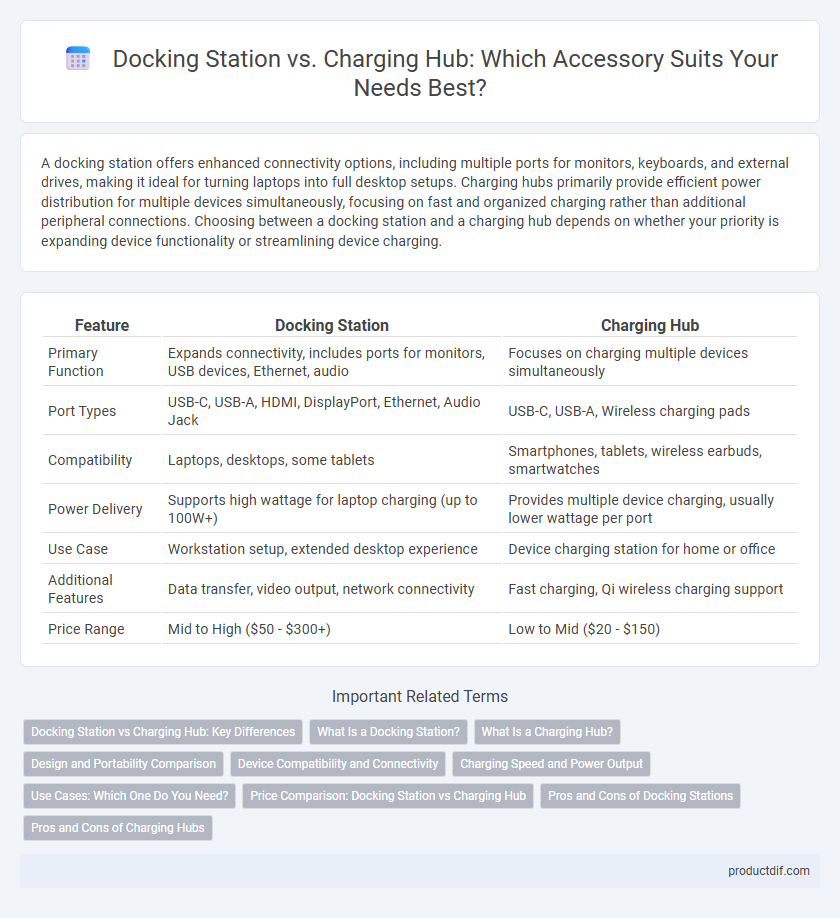A docking station offers enhanced connectivity options, including multiple ports for monitors, keyboards, and external drives, making it ideal for turning laptops into full desktop setups. Charging hubs primarily provide efficient power distribution for multiple devices simultaneously, focusing on fast and organized charging rather than additional peripheral connections. Choosing between a docking station and a charging hub depends on whether your priority is expanding device functionality or streamlining device charging.
Table of Comparison
| Feature | Docking Station | Charging Hub |
|---|---|---|
| Primary Function | Expands connectivity, includes ports for monitors, USB devices, Ethernet, audio | Focuses on charging multiple devices simultaneously |
| Port Types | USB-C, USB-A, HDMI, DisplayPort, Ethernet, Audio Jack | USB-C, USB-A, Wireless charging pads |
| Compatibility | Laptops, desktops, some tablets | Smartphones, tablets, wireless earbuds, smartwatches |
| Power Delivery | Supports high wattage for laptop charging (up to 100W+) | Provides multiple device charging, usually lower wattage per port |
| Use Case | Workstation setup, extended desktop experience | Device charging station for home or office |
| Additional Features | Data transfer, video output, network connectivity | Fast charging, Qi wireless charging support |
| Price Range | Mid to High ($50 - $300+) | Low to Mid ($20 - $150) |
Docking Station vs Charging Hub: Key Differences
A docking station primarily expands connectivity options by providing multiple ports for peripherals like monitors, keyboards, and external drives, enhancing productivity for laptops and tablets. Charging hubs focus mainly on delivering simultaneous power to multiple devices through varied charging ports, often with fast charging capabilities. The key difference lies in function: docking stations integrate data transfer and device expansion, whereas charging hubs prioritize efficient multi-device power delivery.
What Is a Docking Station?
A docking station is an accessory that expands a device's connectivity by providing multiple ports for peripherals such as monitors, keyboards, and external drives, enabling a desktop-like experience. It supports data transfer, video output, and power delivery through a single connection, making it ideal for laptops and tablets. Unlike a charging hub, which primarily focuses on supplying power to multiple devices, a docking station enhances overall productivity by integrating various functions into one compact unit.
What Is a Charging Hub?
A charging hub is a centralized accessory designed to power multiple devices simultaneously through several USB ports or wireless charging pads, streamlining cable management and reducing clutter. Unlike docking stations, which often provide extensive data transfer options and video output for laptops, charging hubs primarily focus on delivering efficient power supply to smartphones, tablets, wearables, and other portable electronics. High-capacity charging hubs support fast charging technologies such as Power Delivery (PD) and Quick Charge, enhancing device compatibility and charging speed.
Design and Portability Comparison
Docking stations typically feature a larger, bulkier design to offer extensive connectivity options, making them less portable but ideal for stationary setups. Charging hubs prioritize compactness and lightweight construction for easy transport, while offering fewer ports primarily focused on power delivery. The choice between the two hinges on balancing the need for multiple device connections against the convenience of portability.
Device Compatibility and Connectivity
Docking stations offer extensive device compatibility by supporting multiple ports such as USB-C, HDMI, Ethernet, and DisplayPort, making them ideal for connecting laptops, monitors, and external storage with high-speed data transfer and video output. Charging hubs focus primarily on power delivery, providing multiple USB charging ports compatible with smartphones, tablets, and smaller gadgets but often lack video or network connectivity options. Users requiring versatile connectivity for workstations should choose docking stations, while those prioritizing simultaneous charging for multiple devices will benefit more from charging hubs.
Charging Speed and Power Output
Docking stations typically offer higher power output and faster charging speeds compared to charging hubs, as they are designed to support multiple devices with efficient power distribution. Charging hubs often provide moderate power output focused on convenience and compatibility with various USB devices, which can result in slower charging times. For users prioritizing rapid device charging, docking stations deliver superior performance through advanced power management technology.
Use Cases: Which One Do You Need?
Docking stations are ideal for users needing expanded connectivity for laptops, offering multiple ports like USB, HDMI, and Ethernet to transform a mobile device into a full workstation. Charging hubs focus primarily on powering and organizing multiple devices simultaneously, making them essential for households or offices with various smartphones, tablets, and accessories. Assess whether your priority is enhanced device connectivity and desktop setup versatility or efficient, centralized charging to determine the best accessory for your needs.
Price Comparison: Docking Station vs Charging Hub
Docking stations typically cost between $100 and $300, offering multiple ports and extended connectivity options, while charging hubs are generally priced from $20 to $80, focusing primarily on simultaneous device charging. The higher price of docking stations reflects their enhanced functionality, including video output, Ethernet, and data transfer capabilities. Charging hubs provide an affordable solution for users needing efficient power distribution without the added features of a docking station.
Pros and Cons of Docking Stations
Docking stations offer extensive connectivity options, including multiple USB ports, video outputs, and Ethernet, making them ideal for users requiring a full desktop setup. They support high-performance data transfer and enable simultaneous charging of multiple devices, enhancing productivity and convenience. However, docking stations tend to be bulkier, more expensive, and less portable compared to charging hubs, which may limit their suitability for on-the-go use.
Pros and Cons of Charging Hubs
Charging hubs offer a centralized solution for powering multiple devices simultaneously, reducing cable clutter and enhancing organization. They typically provide fast charging capabilities and compatibility with various device types, making them versatile for home or office use. However, charging hubs may have limited port availability compared to docking stations and often lack advanced data transfer functions, which can restrict their utility for users needing integrated connectivity.
Docking Station vs Charging Hub Infographic

 productdif.com
productdif.com